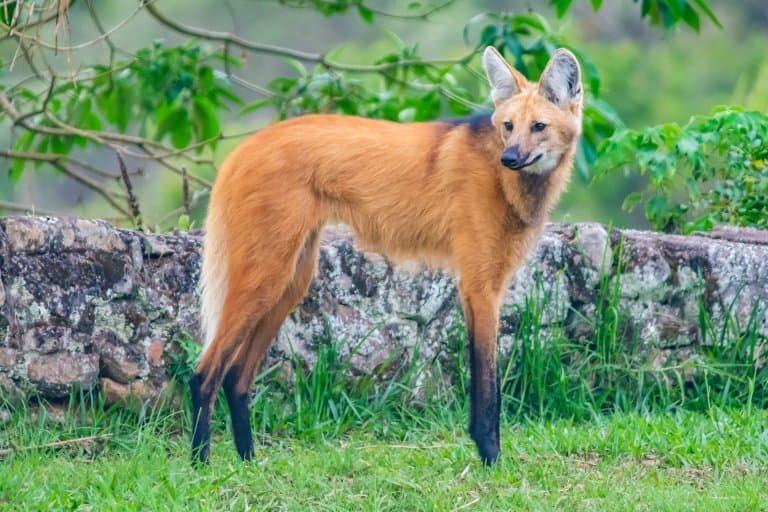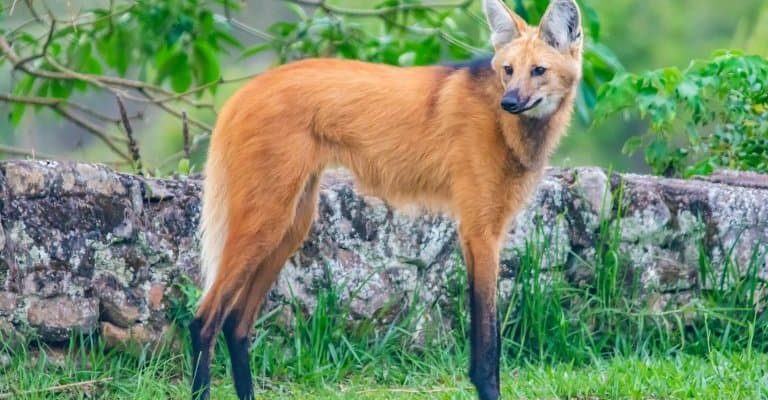
Found mostly in the grasslands and savannas of South America, the Maned Wolf has adapted brilliantly to its environment. But there’s a lot more to discover! Let’s dive into some incredible facts about this remarkable creature that will leave you appreciating nature just a little more.
1. Unique Appearance
One of the first things you’ll notice about the Maned Wolf is its striking appearance. With its long, spindly legs and large ears, it almost looks like a blend of a deer and a wolf. These adaptations aren’t just for show; they help it navigate the tall grasses of its habitat.
The reddish-brown fur is another standout feature. It has a distinct mane of longer hair along its neck and back, which stands up when the wolf feels threatened. This gives it a rather majestic look when you see it on alert. Honestly, if you spot one, it feels like you’re seeing a little piece of wild magic!
And let’s not forget about those big ears! The large ears of the Maned Wolf are perfectly tuned for picking up sounds in the grassland. This helps them hunt rodents and other small animals, making them excellent nocturnal hunters.
2. Not a True Wolf
You might be surprised to learn that despite its name, the Maned Wolf isn’t a true wolf at all. Here’s the thing: it belongs to its own genus called *Chrysocyon*, which means “golden dog.” This distinction is important because it highlights that the Maned Wolf is not closely related to other wolves or dogs, even though it shares some similarities.
This unique classification makes the Maned Wolf an interesting subject for zoologists studying evolution. They’re more closely related to foxes than to the wolves we typically think of. Isn’t that wild? This divergence from other canids is what makes them such a fascinating part of our global biodiversity.
Moreover, their behaviors, such as their mating rituals and vocalizations, can be quite different from those of typical wolves. You might even notice their unique call, which sounds like a cross between a howl and a yip.
3. They Have a Distinct Diet
Maned Wolves are known for their unusual diet, which doesn’t primarily consist of meat. Instead, they are omnivorous and often snack on fruits, particularly a type of fruit called the wolf apple. This is where they differ from their more carnivorous cousins.
They also enjoy small mammals, birds, and insects, making them very adaptable eaters. This diet helps them thrive in their native habitats. It’s interesting to think about how this adaptability helps them survive in the wild, especially when food sources are scarce.
Plus, their ability to eat fruits means they help spread the seeds of these plants, playing an essential role in their ecosystem. It’s a cool reminder of how interconnected nature can be!
4. Wanderers of the Grasslands
Maned Wolves are known for their wide-ranging territories, often roaming up to 40 square miles in search of food. They’re not your typical pack animals; instead, they tend to be solitary or come together in pairs during mating season.
This wandering lifestyle makes perfect sense when you think about their diet. With so many food options scattered across vast grasslands, it’s no wonder they have to cover so much ground. Here’s a fun tidbit: they often communicate their territory by urine marking, just like other canids, but a bit more artistically!
Their nocturnal nature means they’re most active at night. So, if you’re out in the grasslands after dark, keep your eyes peeled—you might just catch a glimpse of these stunning creatures trotting through the underbrush.
5. Unique Vocalizations
You might be wondering how the Maned Wolf communicates with others of its kind. Unlike traditional wolves, they don’t rely solely on howls. Instead, their vocal repertoire includes a variety of sounds, such as barks, growls, and yips.
One of their most distinctive sounds resembles a high-pitched bark that echoes through the grasslands. This vocalization is often used to establish territory or to communicate with a mate. Isn’t it fascinating how different animals have their unique “languages”?
Just imagine standing in the quiet of the evening, hearing those unique sounds drifting through the air. It adds a whole new layer to the symphony of the night.
6. Threats to Their Survival
Sadly, the Maned Wolf faces several threats in the wild. Habitat loss due to agriculture and urban development has significantly reduced their living space. Imagine having your home taken away because a city is expanding—it’s a tough reality for these magnificent creatures.
Additionally, they are often victims of road accidents, and their populations are also sometimes affected by diseases like canine distemper. This is alarming because it means not only are they losing their homes, but their health is at risk too.
Conservation efforts are crucial for their survival. Protecting the grasslands and creating wildlife corridors can help ensure that these animals continue to thrive in their natural habitats. It’s a heartening reminder that every little effort to conserve nature can make a significant difference.
7. Reproduction and Parenting
When it comes to reproduction, Maned Wolves are monogamous, forming strong pair bonds. Each year, they typically have one litter of pups, around two to six at a time. This is pretty special, as many other canids tend to have larger litters.
The pups are born blind and rely heavily on their parents for food and protection. Here’s where it gets interesting: after weaning, the parents continue to care for the young for several months, teaching them essential survival skills. Just like human family dynamics, these wolves have a strong sense of responsibility toward their offspring.
As the pups grow, they begin to join their parents on hunts, learning the ropes of their unique diet. Watching this nurturing process is a beautiful reminder of how, in the wild, life continues in cycles, with each generation learning from the last.
8. Fascinating Adaptations
Maned Wolves have developed several adaptations that make them truly fascinating. Besides their long legs for navigating tall grasses, they also have a keen sense of smell and sight. This helps them detect prey from a distance, which is essential for their hunting practice.
Another intriguing adaptation is their diet, which allows them to thrive in environments where food isn’t always plentiful. Being omnivorous means they can capitalize on different food sources depending on the season, thus ensuring their survival even when conditions change.
They also have a unique way of moving, often trotting gracefully on their long legs. Just picture it—running elegantly through the grasslands, adapting perfectly to their surroundings. It’s a true testament to nature’s ingenuity.
9. Cultural Significance
In some South American cultures, the Maned Wolf holds a unique place in folklore and local mythology. For some communities, this wolf symbolizes strength and cunning, appearing in various stories and legends.
Their presence in these tales helps highlight the importance of the Maned Wolf in the ecosystem and the respect that local people have for wildlife. It’s heartening to see how animals can inspire human creativity and culture, reminding us of our connection to nature.
This cultural significance underscores the importance of protecting these creatures. Preserving their habitats not only helps maintain biodiversity but also keeps these rich stories and traditions alive for future generations.
10. Conservation Efforts
As we’ve discussed, the Maned Wolf’s survival is increasingly threatened, but there’s hope! Numerous organizations are working hard to raise awareness and protect their habitats. Conservation programs focus on restoring grasslands and connecting fragmented habitats, allowing these beautiful creatures to thrive.
In addition, educational initiatives aim to teach communities about the importance of the Maned Wolf and its role in the ecosystem. The more people know about these animals, the more they can advocate for their protection.
You can even play a part! Supporting wildlife conservation organizations or visiting natural reserves can contribute to these efforts. It’s a small step that can collectively lead to significant change.
In conclusion, the Maned Wolf is a remarkable creature with a wealth of fascinating facts that remind us of the beauty and complexity of nature. From its unique appearance and diet to its role in cultural mythology, there’s so much to appreciate about this special animal. By learning and sharing these facts, we can help raise awareness for their conservation. So next time you think of wolves, remember there’s a whole world of wonder beyond the typical howl of the pack.

